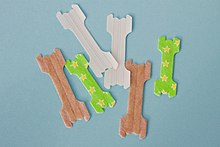Nasal patch
Nasal patches or nasal strips consist of a strip of adhesive plaster , the ends of which are broadly rounded. There are thin strips of plastic between the two layers that make up the plaster to stiffen the plaster. The nasal patch is stuck over the bridge of the nose in such a way that the nostrils are pulled slightly upwards by the bend in the plastic reinforcements. This is intended to make nasal breathing easier.
The nasal patch was developed in the United States in the early 1990s and is now marketed primarily by the GlaxoSmithKline company under the name “Breath Right”. Nasal patches are used in sports to improve physical performance. However, this increase in performance was denied in tests. They are also used in the therapy of allergies , snoring should be reduced significantly.
Use in humans

In humans, the nasal cavity is the narrowest part of the airway, and with high physical exertion this passage narrows due to a drop in pressure. Nasal patches are stuck to the nostrils and are supposed to keep the airways free.
They offer a drug-free way to maintain a clear airway with a product that is available over the counter. They have no side effects other than occasional skin irritation from the adhesive. When used correctly, they can widen the airways. Scientific studies have shown, however, that a performance-enhancing effect cannot be clearly demonstrated.
They are mainly used during sports, especially when a mouthguard that hinders breathing is worn. They can be used instead of nasal drops or sprays for colds , although blockages usually occur further above. They also reduce the volume when snoring.
Use in horses
They are considered helpful in horses because they cannot breathe through the mouth, but only through the nose. The patches are believed to minimize air resistance and reduce the risk of Exercise Induced Pulmonary Hemorrhage , as well as to minimize fatigue and facilitate post-race recovery.
The version for horses was invented by two veterinarians, James Chiapetta and Edward Blach. In the 1990s, inspired by the nasal strips used in humans, they came up with the idea of using a similar product on horses. They agreed a license with CNS, the then manufacturer of "Breath Right".
Individual evidence
- ↑ Abendblatt.de
- ↑ a b Lauri I. Peltonen et al .: Effects of the nasal strip and dilator on nasal breathing - a study with healthy subjects (PDF) In: Rhinology . Pp. 122-125. 2004. Retrieved May 29, 2014.
- ↑ Stanford Sleep Surgery - Otolaryngology ( Memento of March 16, 2015 in the Internet Archive )
- ↑ Munish Bhardwaj: Nasal Strips . Disabled-world.com. August 8, 2008. Accessed on May 29, 2014. ( Page no longer available , search in web archives ) Info: The link was automatically marked as defective. Please check the link according to the instructions and then remove this notice.
- ↑ YES O'Kroy: Oxygen uptake and ventilatory effects of an external nasal dilator during ergometry . In: Med Sci Sports Exerc , 32, 8, August 2000, PMID 10949017
- ↑ Tom Overend et al .: External Nasal Dilator Strips Do Not Affect Treadmill Performance in Subjects Wearing Mouthguards . In: Journal of Athletic Training , Jan – Mar 2000, PMC 1323440 (free full text)
- ↑ LR Høyvoll et al .: Effects of an external nasal dilator strip (ENDS) Compared To xylometazoline nasal spray . In: Eur Arch Otorhinolaryngol , 264, 11, November 2007, PMID 17530269
- ↑ Exercise-induced pulmonary hemorrhage in the English language Wikipedia
- ^ Regina Nuzzo: Straight from the horse's nose . ESPN. May 24, 2014. Retrieved May 27, 2014.
- ↑ Parija Kavilanz: Meet the maker of California Chrome's nasal strip . CNN Money. June 5, 2014. Retrieved June 5, 2014.

